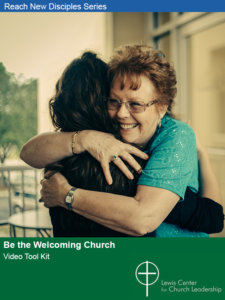How can your church reach new people in today’s evolving ministry context? Ann Michel of the Lewis Center staff interviews Tony Morgan, chief strategist for The Unstuck Group, about trends, perspectives, and strategies drawn from his work with scores of congregations across the country and abroad.
Listen to this interview, watch the interview video on YouTube, or continue reading.
Ann Michel: Different churches weathered the challenges of the pandemic in different ways. But speaking very generally, what do you think is most different in the overall context of ministry right now as a consequence of two years of coping with the pandemic?
Tony Morgan: I would go back even before the pandemic. It was very obvious, even a few years ago, that some churches were actually seeing a lot of growth. They were thriving. There was a lot of momentum around their ministry. As a result, they were seeing a lot of life transformation as people were taking steps towards the church and towards a relationship with Jesus. And at the same time, there were a number of churches that were in decline. They were plateaued. They weren’t just seeing declining attendance; they weren’t seeing a lot of life change happening either.
What we’ve noticed as a result of the pandemic is the distinction between healthy churches and declining churches has accelerated. I think to a large extent that’s because even before the pandemic the churches that tended to be the healthiest were those able to look at their current context, recommit to things that were working as part of their mission, but also change in response to their surrounding circumstances. And now, given the disruption of the last few years, I think the churches that can identify what’s working and what allows them to accomplish the mission God is calling them to have doubled down on those things. But at the same time, they remain openhanded with areas that need to shift because of what we’ve experienced. And those churches seem to be thriving on this side of the pandemic, as well.
Ann Michel: So, the churches that were the most adaptable and healthiest before the pandemic are also the healthiest coming out of the pandemic. It makes total sense. Yet there seem to be few churches where in-person attendance has rebounded to pre-pandemic levels. I want to know what you’re seeing with regard to attendance and what you’re recommending to your clients.
Tony Morgan: We’re encouraging pastors and church leaders to stop comparing attendance to where we were two or three years ago. Instead, we encourage them to just look at where they are compared to a year ago because that gives us a picture of the trends that are happening currently. If we were to take attendance today and go back 12 months, there are some churches, not a lot, but some churches seeing year-over-year growth again. And to me that’s encouraging and that we’re celebrating. At the same time, there’s no doubt about it, many churches are not seeing the attendance patterns they saw before COVID, and there are still churches that are declining even at this point in the pandemic. In other words, if we were to look at their attendance today and compare it to 12 months ago when we were still in the middle of COVID, they are still declining. If more than two years into COVID attendance patterns are still declining, red lights should be going off on the dashboard saying, “Hey, wait a second. We may need to look at things a little bit differently than we did last year or even a few years ago. It might be time to pay attention to how we’re engaging our mission and how we’re trying to reach new people outside the church and outside the faith.”
Churches that are winning in this season are seeing a lot of new people coming to church. Churches that are intentional about designing their Sunday worship experiences and their ministry strategy with new people in mind, are seeing a lot of new people in this season. We really need to pay attention to those stories right now.
Ann Michel: I wonder if there’s a little bit of a pent-up demand. Some new people may have been holding off on coming into a new church until it felt safe to do so.
Tony Morgan: I couldn’t agree more. We studied the data from all the churches we’re working with and many more churches around the country and around the world. As an example, at my church I volunteer in what we call “The Connection Space” where people that are brand new to the church often come before or after the services. And just this past Sunday, I met with a variety of folk. Some were new to the area and trying to find a new church. And there’s a lot of movement happening around our country right now, so that shouldn’t be surprising. There were people that have been watching services online for years and, for whatever reason, this past Sunday they just decided “We’re actually going to go to church for the service.” But the more common theme I’m hearing in these anecdotal conversations is that people are dealing with the challenges of life that, to some extent, all of us have experienced.
It’s not just churches that have been disrupted. People’s lives have been disrupted over these last couple years. There are issues of isolation and loneliness, stress and anxiety, and job loss. There have been relational breakdowns. And people are trying to figure out what they’re going to do next in life. As a result, I think people are searching for answers and for relationships with other people to walk them through these situations. And I just love the fact that they’re showing up to church on Sunday morning to try to pursue whatever they’re sensing is out there for them. I think they sense there may be a spiritual answer to this, and they’re showing up on Sunday morning, which we should expect. I don’t know why we’re surprised by that, especially given what we’ve experienced the last couple years.
I’m not naturally an optimistic person. At the very beginning of the pandemic, I was concerned about what this would do for people connecting with churches, the financial ramifications, and things like that. But I kept sensing that this could be one of the biggest opportunities the church has experienced in a long, long time. As I’m having these conversations with people on Sunday morning, I think this may be an answer to that prayer that I started to pray a few years ago, a couple years ago at the beginning of COVID, that we might see revival in the church as a result of what we’ve gone through as a society over the last couple years. So, that’s pretty encouraging for me.
Ann Michel: Everybody today is talking about hybrid ministry. It’s almost a buzzword that seems to mean different things in different contexts. What are some of the more successful patterns of hybrid ministry that you see emerging?
Tony Morgan: At the same time that everybody’s talking about it, this can be very overwhelming for pastors and church leaders. None of us were trained to be online churches. So, let me share some of the basics I’m seeing in churches that seem to be getting some traction around online ministry.
First, they’re not trying to replace everything that they do as a church online. After people find faith, after they begin their relationship with Jesus, they really need to experience spiritual formation through our discipleship strategies. All of these steps involve highly relational ministry. It’s very difficult for us to become more like Jesus and to take our next steps towards Christ if we’re not in relationship with other people. And, honestly, it’s very hard to replicate that online.
On the other hand, churches that are finding some momentum around their digital strategies recognize there’s a lot of opportunity to connect with brand new people using online platforms. This really is the new front door for churches. So, the first principle is, rather than trying to replicate everything we do as a church online, I encourage pastors and church leaders to focus on the front door potential of online platforms. How can we leverage online to connect with people that aren’t currently a part of our church? Honestly, that’s probably more than just putting your services online. How can you provide practical articles and other online content that people in your congregation will want to share that with their network of friends? Those things may help you get a little bit more traction around digital ministry strategies.
The second key principle is sometimes we forget that even online ministry is all about people. It’s all about ministry. I get kind of passionate about this topic because I think we sometimes let the online part get in the way. As pastors and church leaders, we know how to do ministry, we know the mission that God’s called us to, and we know how to help people. Sometimes we get caught up in all the razzle dazzle of social media and websites and podcasting and technology. We need to just go back to what we do well, which is helping people take their next steps towards Jesus. Then, if we have questions about the technology itself, there are all kinds of organizations and people that can help leverage the right technologies to make ministry happen. Sometimes we think we have to be the experts on the technology, and we’ve not been trained to do that. We’ve been trained to help people take their next steps toward Christ. So, let’s find the experts that can help us with the technology. And let’s stick to what God’s called us to do, which is help people find Jesus and take their next steps of faith.
Ann Michel: One of the findings in The Unstuck Group’s most recent quarterly report is that declining churches employ 56% more full-time equivalent employees than growing churches, which suggests that church staffing levels and configurations could be a drag on growth. Can you speak to that and share some thoughts about what it means to be staffed for growth?
Tony Morgan: Let me first say the solution to becoming a healthy, thriving, growing church isn’t just to go into your office and fire a bunch of staff. But this finding probably does speak to some underlying challenges or issues. The most obvious one may be that, when churches are overstaffed, they’re not encouraging as many volunteers and lay people to engage in ministry. As we’ve looked at some complimentary data around volunteer engagement, we find those who volunteer show up to church more consistently. They’re more likely to invite friends, neighbors, family to join them at church because they feel more invested in the mission of the church. And there is a dollars-and-cents aspect, as well. When we’ve looked at financial giving records, people that serve in ministry in some capacity also give at the highest levels.
So, it doesn’t surprise me that overstaffed churches tend to struggle more than churches that are lean in their staffing. Churches that are lean in their staffing recognize they can’t just hire people to do ministry. They hire people to lead volunteer leaders and build volunteer teams to get ministry accomplished. As a result, not only are they hiring higher capacity people, but they have more financial resources to compensate fewer people better. And that helps with retaining high-capacity leaders. My suspicion is, if you retain great staff leaders, if you have continuity of staff leadership over time, that also produces health and momentum.
There are probably a lot of compounding factors here. But if we don’t really think about this, we might assume one reason some churches are growing is they can afford to hire more staff. The reality is, it’s just the opposite. It’s just fascinating when you start to dive into these details.
Ann Michel: I think one consequence of a church being overstaffed is the staff spends so much more time coordinating with one another and the senior leader spends so much more time managing staff that it leads to an inward focus. Since you mentioned staff retention, I’m sure you’ve seen the stories in the popular press about pastors quitting the ministry in droves. Yet there’s also been research suggesting this trend isn’t quite so dire. To what extent is The Great Resignation impacting pastors and the church workplace?
Tony Morgan: In the last 12 months, we’ve worked with more than 100 churches. Anecdotally, I am hearing that there does seem to be a little more transition on staff teams in recent months. Honestly, I think a lot of that is because in the early days of COVID, most of us had no idea what might happen. And as a result, we went about a year where nobody was really changing jobs. They were concerned, “If I quit my job, am I going to be able to find a new job?” So, we went about a year without a lot of staff transition, even in the context of churches. Some of the transition in recent months is, I think, just because of pent-up demand. People are just looking to change and take a next step in their ministry or career.
Age is another compounding factor, even before COVID, especially in pastoral positions. I am talking with a lot of pastors that are considering succession and transition. But honestly, they should be talking about it because they’re in their early to mid-60s and it’s time to pass off ministry to the next generation. So, it’s hard to say how much of this is COVID-related and how much is just the passing of ministry to the next generation, but it is a topic that is coming up in my conversation with pastors and church leaders.
Ann Michel: Another thing that struck me in your quarterly report is that most of the financial indicators looked pretty good. What accounts for that? And what can congregations learn that might help them keep their financial houses in better order?
Tony Morgan: First, recall that the government stepped in to help all kinds of organizations with the Payroll Protection Program, and that certainly helped the churches that participated. Another factor is that for a number of months ministries weren’t meeting in physical spaces, and there were some costs they didn’t incur for a time. But if we just look at the averages, it suggests that giving patterns are really on par with where they were pre-pandemic. There are extremes to that data, too. Some churches are far better in terms of giving and finances on this side of the pandemic. But other churches are really hurting financially. The biggest factor we’re seeing is that the churches that leaned into the crisis moment and had an intentional strategy to invest in the community and to stay on mission during COVID have come out in a better place financially. On the other hand, the churches that hunkered down and were almost in survival mode just trying to figure out how they could just continue to do what they’d always done are, more often than not, struggling financially in this season.
 Related Resources
Related Resources
- Why Church Leaders Can’t Afford to Wait and See by Tony Morgan
- 4 Truths About Ministry Revealed by the Pandemic by Tom Berlin
- What to Watch in 2022 by Doug Powe and Ann A. Michel
- Be the Welcoming Church Video Tool Kit






